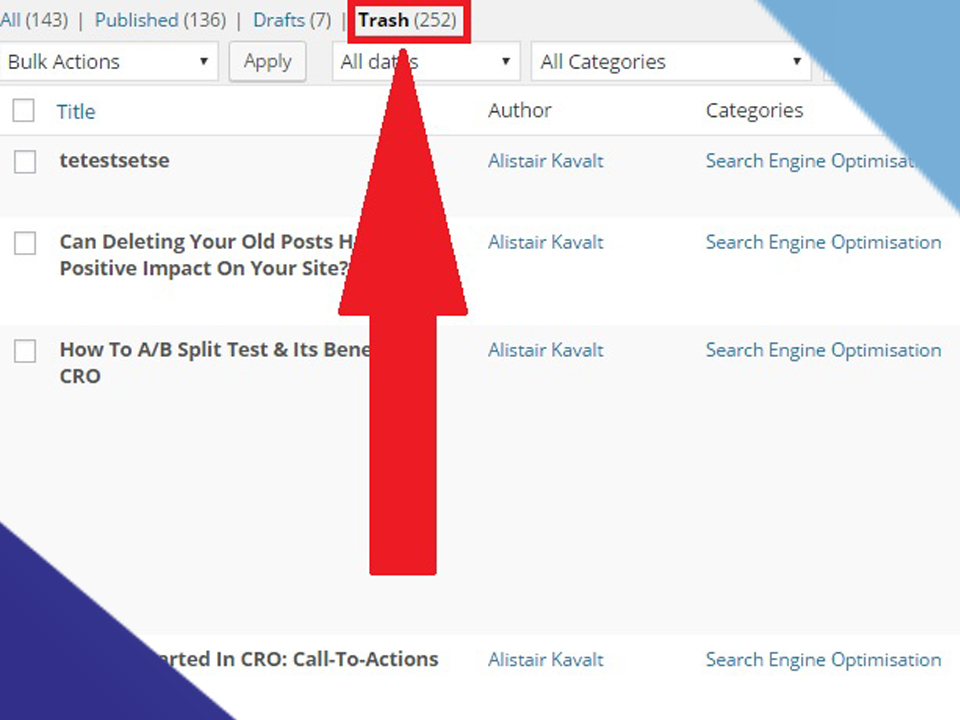
It seems counter-intuitive; those hundreds or even thousands of articles you created for your site just being thrown into the trash as if they never existed. Those long hours you put into writing them, all for nothing. But that’s exactly what I did a few weeks ago when I removed any of my low-ranking articles as an experiment to improve the search engine rankings on this website, and I don’t regret the decision in the least bit. Why does this improve search engine rankings, you ask? Allow me to explain.
How Can Removing Articles Possibly Improve Search Engine Rankings?
At one point or another, you’ve probably heard the SEO theory that poorly-ranking pages on your website actually harm your rankings. This theory actually stems from a potential SEO factor regarding your click-through rate (CTR) in the search engine results pages (SERPs); some search engine optimisers are under the notion that a low CTR will have a negative impact on your search engine rankings. However, there are a couple of other suspected SEO factors I took into account while I tested out the primary theory including the following:
- Some SEOs claim that a high bounce rate can be interpreted as a sign of a low quality site by search engines.
- A short session duration, which Google Analytics only picks up on if a user visits another page on your website, can be a sign of a low quality page.
The Process Of Removing & Altering Articles
Despite what I said at the beginning of this article, you can’t just arbitrarily delete your articles and call it a day. If you do this, it’ll cause numerous 404 errors on your website and you increase the likelihood of accidentally deleting a page that receives hundreds or even thousands of visitors a day. On top of that, if you don’t 301 redirect the redundant articles you delete, you could lose out on any link equity those pages have procured.
Now the process I used was fairly simple and consisted of the following steps:
Finding & Deleting The Articles
Step 1: I first went into Google Analytics and set my date range from January 1, 2016 to April 25, 2016. That would allow me to see all of the posts that have been viewed this year according to the data from Google Analytics.
Step 2: From there, I scrolled down and took note of any URLs that met one of the following criteria I came up with for a low-quality article:
- 5 sessions or less.
- A 100% bounce rate and less than 5 sessions.
- A low average session duration.
Step 3: I then searched for all of my other posts on this website to see if they appeared on this list at all. If they were old and received little or didn’t receive any traffic based on the analytics data, I deleted them.
Altering & Merging The Articles
I figured since I was deleting articles from this website, I may as well cleanup and merge similar articles.
Step 1: I merged articles I viewed as redundant and 301 redirected them to similar articles that were ranking well. This enabled me to reduce the number of 404 errors on this website.
Step 2: I cleaned up any formatting issues on the remaining pages and updated my other articles with fresh information.
Step 3: As far as articles that ranked for their primary and LSI keywords, but didn’t receive many unique visitors, I used conversion-rate optimisation (CRO) tactics to increase their CTR. You can read more about this in my guide titled, “The Complete Guide To Conversion Rate Optimisation“.
The Results: Can Removing Article Improve Search Engine Rankings?
Update (May 31, 2016)
Well, it’s been over a month since I made the changes above to this website, and here’s what happened.
During the first half of the month, my rankings were fluctuating so wildly that I thought this site was going to tank. As I was getting ready to order a coffin for this website, something interesting happened on the 15th of May that I didn’t expect: the total clicks and traffic to this website were not only slightly better than before, but the average position for this website improved slightly. All of this happened on the same day that Google deindexed the pages I removed. Ever since then, the traffic to this website has been steadily increasing and the traffic fluctuations have stopped.
Most of the data, except for the average rankings positions, are shown below.
Conclusion
I have to say, this was a very interesting experiment that led to surprisingly positive results. It appears that even though I removed the articles without 301 redirecting them to different pages, Google did not have an issue with this. I still wouldn’t recommend doing this to your own website as this was just one test, although I am, again, surprised that the results were positive.
